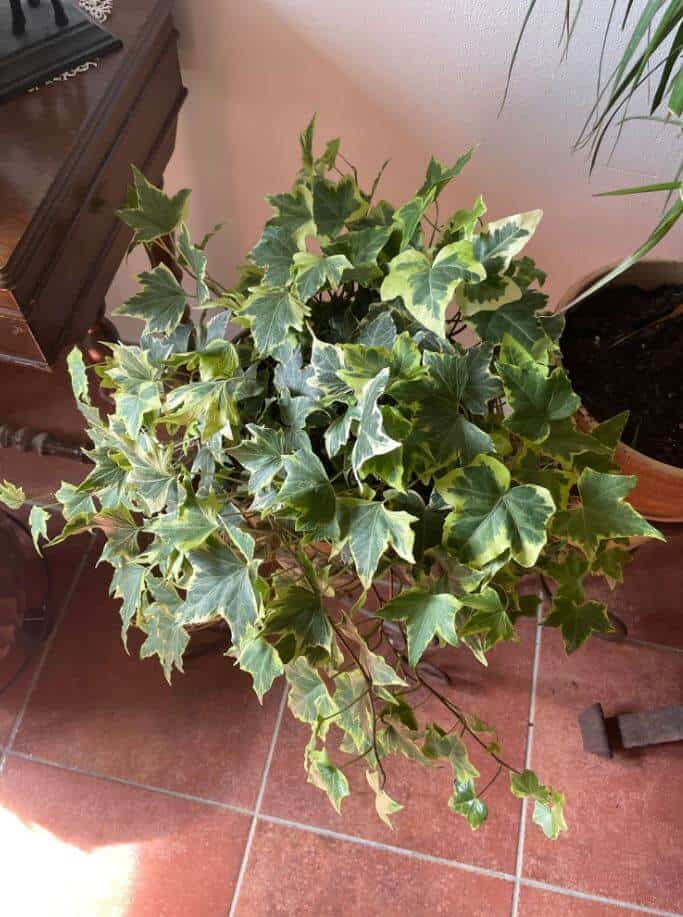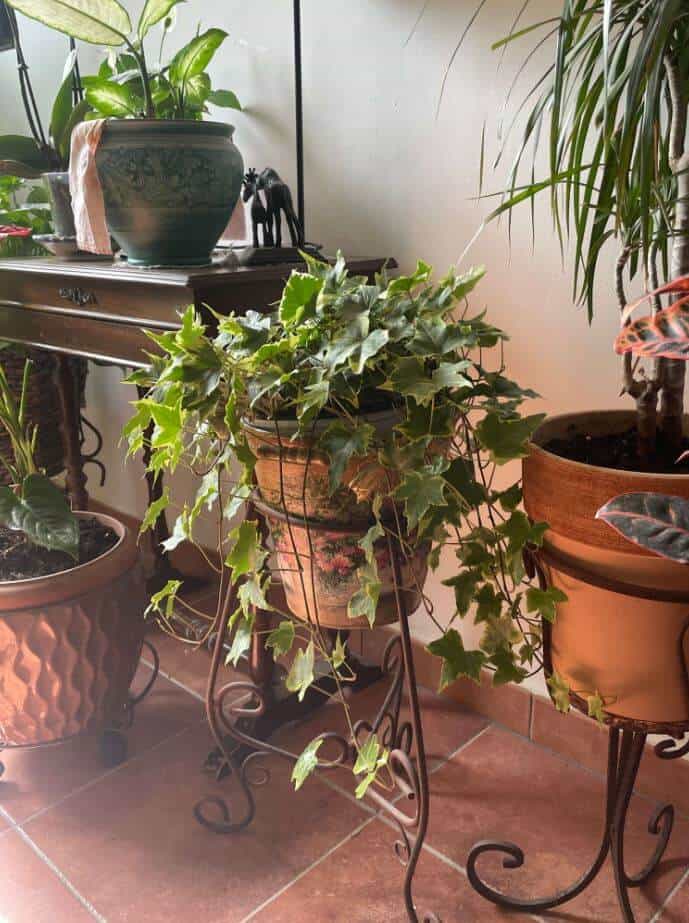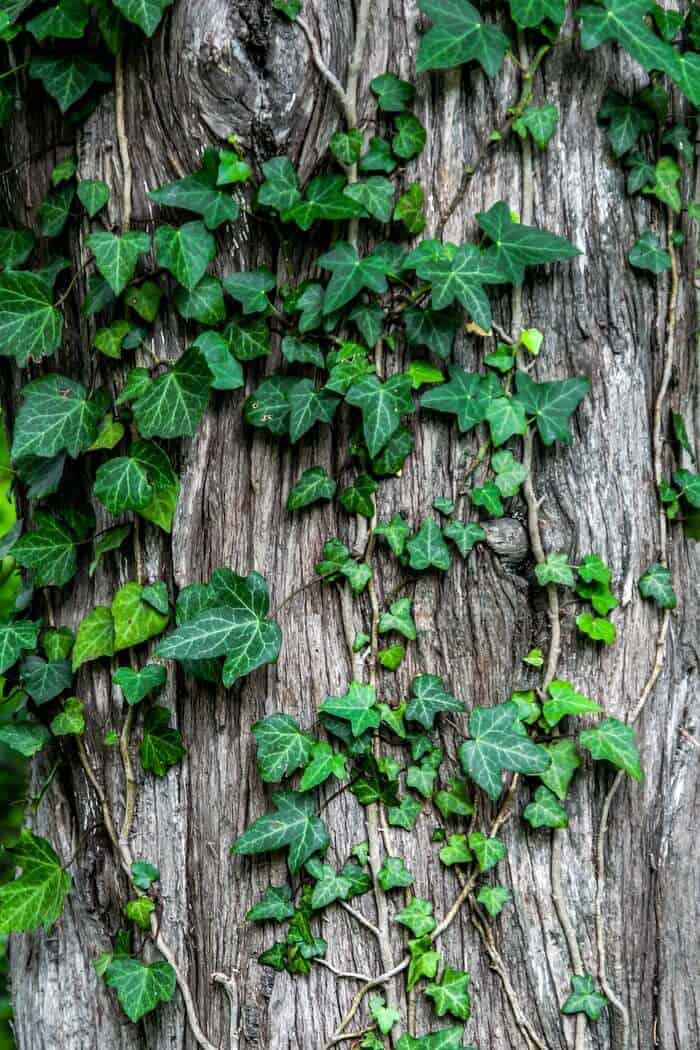Last Updated on January 9, 2023 by a Friendly Gardener
The ancient Romans believed ivy was sacred for Bacchus, the Roman god of wine. The ancient Greeks felt it was sacred to Dionysus. Yet in times more recent, the famous Christmas carol “The Holly and the Ivy” is an ode to its importance.
Ivy is a beautiful plant that boasts lush hanging vines. Generally considered an invasive outdoor plant, it will cover walls, buildings, and trees quickly and completely. This is an aggressively rapid grower.

Known as the plant that covers numerous college buildings in the northeastern United States conferring these institutions with the moniker of “Ivy League Colleges”. Unfortunately, many popular English Ivy species can provoke extensive damage to buildings, facades, and brickwork as well as trees. It is considered to be an invasive species in the U.S., so if you plan on cultivating it outdoors check local regulations for your area.
Ivy is not difficult to cultivate as an indoor houseplant. But it’s crucial to keep it happy. Trailing vines can grow as long as 50 feet or more. They will fill up with heart-shaped leaves in various hues of green, some with variegated patterns.
English ivy is the most common cultivar sold in nurseries and garden centers. Individual indoor varieties generally offer more than one cultivar giving you lots of ivy plants to choose among. There will be a variety of solid greens, and variegated greens with shades of white, cream, yellow, gray, and even black. Foliage will also come in various shapes.
If you cultivate ivy outdoors, consider spots that are difficult to grow other plants in, because ivy works well as a ground cover. It does need shade from direct summer sunlight exposure, and protection from the wind and winter weather.
Ivy Plant Care

Ivy is often considered a finicky plant for indoor cultivation, but with the proper indoor environment, it can be a glorious addition to your home décor. Ivy is a climber, so a trellis, pole, or something to attach to is important. It can also be cultivated in hanging baskets from which it will cascade down. You can use wire cages or frames to create living sculptures with your plant.
Soil
A loose potting mix is ideal for a happy ivy plant. It must be well-draining. Ivy will adapt to various soil mixes and types with a wide variety of pH and nutrient levels. It will thrive in loamy soil. For dryer and warmer climates, use a layer of mulch to help the soil retain moisture. Soil pH is better when neutral or a bit alkaline.
Light
Ivy plants do well when cultivated in full or partial shade. This explains why it thrives as a ground cover and at tree bases. Indoors, it needs bright indirect light in the summer. In its period of winter dormancy, it will benefit from direct light when positioned in a window.
Watering
Ivies like dryer soil, so always touch soil before watering. They also require excellent drainage. Never leave ivy standing in water-logged soil.
Humidity
Ivy does better in medium to high humidity. This should most likely measure higher than average indoor humidity, so use a humidifier or a pebble tray with small stones and water underneath the plant. Misting often can help with the immediate humidity level. Ivy can be grouped together with other indoor houseplants. Transpiration among plants will raise the humidity around them. Another alternative is placing a small bowl of water near the ivy plant.
Temperature
Ivy grows in a range of temperatures from 45° to 80° Fahrenheit. It does not like extremely hot summer or winter weather. When cultivated indoors, plants need to remain cool in the evenings, preferably below 60°F. Ivy will be stressed if a soil bed is too hot, cold, or dry.
Feeding
Feed your ivy plant bi-weekly with a standard 20-20-20 liquid fertilizer in the spring and summer. If the plant is not growing new foliage, refrain from feeding.
Pruning
Pruning is necessary when cultivating ivy outdoors especially if it is grown as a ground cover. Trim it in the spring. Prune ivy to create a bushy shape. Pinch off new tips. Pruning regularly discourages leaf spot bacteria from developing. Radical pruning every two to three years is recommended to revitalize ivy.
If ivy climbs your tree and you want to remove it, cut the vine at the tree base or soil level to interrupt the source of water. Do not pull it off the tree as this may cause harm. An ivy vine growing on a tree trunk will naturally die if it has no water. This may be necessary annually as they are invasive. Indoor ivy can be pruned as needed.
Repotting

If you have a small ivy plant, repot it annually. Repot a larger plant every other year. If your ivy plant is mature and somewhat older, use the same pot and just change the soil.
Ivy Propagation

Use the ivy cuttings from pruning to propagate new plants. Vine cuttings should be about five inches long. Place cut ends in a jar of water and be patient. Change water weekly. Once roots have grown transfer your new ivy plant into new potting soil.
When cultivated as a ground cover, Ivy growing outdoors develops new roots wherever the ivy vine comes into contact with the soil. Cut the vine sections with roots and dig them out. Transfer them to a new pot or location.
Ivy Toxicity
English ivy is toxic to cats, dogs, horses, and humans. Foliage contains triterpenoid saponins making leaves more poisonous than the plant’s berries. Symptoms of poisoning can include:
- Vomiting
- Rash
- Hallucinations
- Fever
- Excessive drooling
- Diarrhea
- Delirium
- Abdominal pain
Call your veterinarian at once if you see your pet eating or chewing on ivy. Keep indoor plants away from small children and pets.
Pests, Diseases, and Problems
Aphids and spider mites are drawn to English Ivy. Remove them by spraying your plant with water. Afterward, treat your ivy with insecticidal soap or with organic Neem oil.
Rhizoctonia root rot and Xanthomonas, better known as Bacterial Leaf Spot are common diseases for ivy. Leaf spot appears with black or darkish brown spots on the plant’s foliage. In the case of Bacterial Leaf Spot, infected plants should be disposed of. Protect your remaining ivy plants by spraying them with vinegar and water. Prepare the spray with a 1 to 10 ratio.
Root rot is most often due to hot, humid weather and is generally lethal for the plant. Diseased plants should be disposed of. Any remaining ivy plants should be treated with fungicide.
Common Ivy Varieties
- Herderacanariensis (Algerian Ivy). Also named Canary Island Ivy, this ivy is native to Africa. It offers several variations and is cultivated much the same as English Ivy.
- Hedera helix (English Ivy). This is the most common type of ivy that you will find for sale in nurseries and garden centers.
- Hedera colchic (Persian Ivy). Persian ivy distinguishes itself with thick, large leathery foliage. If you can’t grow grass, consider this variety as a ground cover. It finds its native habitat in northern Turkey and the western Caucasus.
- Hedera Hibernica (Irish Ivy). This is a larger ivy than the common English ivy. Leaves are wider and feature green veins instead of white ones. Irish ivy is also an invasive species.
- Hedera nepalensis (Nepal Ivy). Related to the hedera Helix, its native habitat is in the Himalayas and eastern Asia.
- Hedera rhombea (Japanese Ivy). Typically found on cliffs, trees, and walls, this ivy variety will have green-hued or green and white variegated foliage with striking purplish-red stems.
A Final Thought

English Ivy is an easy-to-care-for, rapidly growing houseplant. Its trailing vines and variegated leaves when dangling from a shelf, or a hanging basket add style to any décor. They also make lovely plants when hung in a bathroom as they thrive with high humidity and shade.


